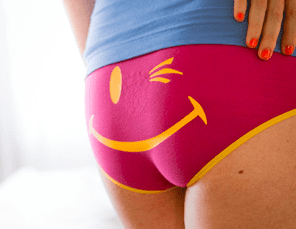
All you want to do is workout but you can’t because it is so uncomfortable.
This article will break down some of the causes of rowers bum and how to prevent it from happening.
Believe it or not, a few simple stretches or positioning corrections, can help alleviate some of this unwanted pressure.
If these solutions don’t work, we can always bust out the secret weapon, a rowing machine seat cushion!
Rowing is such a fun and amazing exercise that should be low-impact and PAIN FREE!
So continue reading below to help fix this annoying issue and start rowing without any discomfort!
[amalinkspro_table id=”14311″ new-window=”on” nofollow=”on” addtocart=”off” /]
What Causes Rowing Machine Butt Pain?
Most rowing machines are manufactured for the average size person. It is difficult to make a one size fits all rowing machine.
So if you are larger or smaller than the average person, your butt may not fit perfectly on the seat. Especially if the seat is molded specifically for rowing.
This slight misfit can lead to rowing machine butt pain or “rowers bum”.
While rowing, a person’s butt bears most of the weight and they must pivot back and forth over their tailbone, butt, and sitting bones. They must also use their glutes (butt muscles) as a primary muscle for powering through their rowing leg drive.
This combination of sitting on your butt, while also using your butt muscles, is very odd combination that can cause some discomfort.
The mere fact your butt is experiencing so much pressure and work can cause you to have rowing butt pain.
Some users may also have bad positioning on the seat or tight muscles, which can lead to poor blood circulation to their butt. After a 20-minutes session, this poor circulation can lead to having a sore butt.
Below I list the most common causes of rowing machine butt pain and what you can do to alleviate some of this discomfort.
How to Prevent Rowers Bum?
While some people will never get rid of rowing machine butt pain 100%, there are a few ways to minimize it.
Below are the most common reasons people experience butt pain from rowing and a few examples of how to prevent it.
Stretch
One of the most important things a rower can do before a training session is stretch.
Getting a good stretch will help loosen all your muscles and allow for better circulation. Being more flexible will also allow you to maintain proper positioning while rowing.
A good warm-up is also necessary and will vary based on your planned workout. At minimum, you should do a 5 minute warmup row to get your blood flowing.
I have an article about preparing for a 2K row which has great examples of static and dynamic stretches to perform before a rowing session.
Below is a video with specific stretches you can perform if you are experiencing rowing machine butt pain.
I included the video below because it shows an examples of “rolling” on a lacrosse ball. If you are not familiar with this technique you need to start incorporating this into your routine!
Rolling on a hard ball is extremely helpful for releasing tension in your muscles and is performed in every physio/physical therapy office. It is a great way to cure any butt or lower back pain.
If you are still experiencing rowing butt pain on longer sessions, try stopping every 20-minutes and performing a quick stretch.
Just getting up, shaking out your muscles, and stretching your butt, can help you continue rowing for another 20-minute session.
Except if you are rowing for time, then you have to fight through it!
Proper Positioning
Another factor to consider when trying to avoid rowing machine butt pain is proper positioning.
First, you must make sure your feet are in the proper place.
When your feet are in the “flexfoot” holders, the strap should run across the balls of your feet. If the strap is not in the proper position, you will need to adjust the holders up or down.
Having your feet too low can cause your thighs to rest on the edge of the seat and cut off circulation.
Wearing different shoes can also effect your foot positioning, so make sure to check your foot placement every time you row.
If you usually row in shoes and then decide to row in socks, you will need to adjust the foot holders higher.
Different shoes also greatly effect your rowing stroke. You can check out my article about the best shoes for rowing here.
Rowers should also make sure they are positioned directly in the center of the seat. Being off center just an inch to any side can cause more pressure to be added to one side of the butt.
While sitting on the seat, you should not feel uneven pressure to any area of your butt.
Proper Rowing Form
Making sure you have proper rowing form can help alleviate pain on your butt and any other areas you are feeling pressure (back, wrists, shoulders, and knees). I have articles to help alleviate all of these pains :)
The first thing to do is watch a few rowing machine technique videos. Who better to learn from than Concept2:
Now that you have the rowing machine technique down, here are a few things to think about while rowing.
First, don’t lean too far back at the finish of your rowing stroke. This can cause added pressure on the tailbone and sitting bones.
If you do feel pressure on any of these areas, try shifting slightly forward or backward on the seat to help alleviate some pressure.
Second, keep your back straight when pivoting from the drive to the finish and vice versa. Keeping a straight back will ensure you are pivoting over your butt correctly.
You also want to make sure while keeping your back straight, you are also keeping your arms straight. Meaning, you are pulling the handle straight back and forth.
Just being right or left-handed can cause you to favor one side, which will cause you to add more pressure to one side of your butt.
Third, try rowing strapless to find your proper form. This means take your feet out of the strap and try rowing. This will prevent you from rowing out of control and leaning too far back. It will also tell you if you are leaning too far to one side or the other.
Rowing strapless is a great way to expose any rowing inefficiencies!
Give it Time
If you are experiencing rowers bum during the first week of rowing, you have to give it more time.
Anytime you start a new form of exercise there are going to be aches and pains until your body gets used to the movement.
Your butt should get used to sitting for longer periods of time and begin to develop strength in those areas.
You may also be experiencing some pain due to sore muscles. Having a sore bum from rowing can dissipate over time as your muscles become stronger.
As your butt becomes tougher and your muscles become stronger, you should experience less butt pain.
If you are rowing for longer than 1 hour at a time, you must also realize that any activity where you are putting pressure on one area for an hour is going to cause some discomfort. This is just something all rowers have to deal with.
Rowing Machine Seat Cushion
If all else fails and you want a quick, easy fix, then grab a rowing machine seat pad.
Adding a seat cushion will obviously give your butt a little support and keep it off the hard seat.
While the hard seat is designed for speed and efficiency, sometimes we just want something soft to sit on!
There are a few factors to keep in mind when adding a cushion to your rowing machine.
First, know that too much cushion or too firm a cushion can actually do more harm than good. A thick, firm cushion can actually add more pressure underneath your thighs and prevent proper circulation.
A well-designed rowing machine seat cushion made from high-quality memory foam will prevent this from happening.
Second, make sure to readjust your foot positioning when adding a seat pad. You may end up sitting a little taller while on your rowing pad, so you will have to adjust the feet a little higher as well.
Third, make sure your seat is on properly with a cut-out in the back for your tailbone. The rowing seat pad should also have a cut-out for the tailbone as well.
This ensures there is no pressure on your tail bone when leaning back and pivoting forward.
I have an entire article on the best rowing machine seat cushions with a few great recommendations.
Other Factors
The factors listed above are the main causes for rowing machine butt pain. If you continue to experience rowers bum, then you may have some of the issues listed below.
Many people buy rowing machines to lose weight and get in better shape. If you are currently overweight, this may cause more pressure than normal on your rear and lead to rowing butt pain.
You may have to give your butt time to adjust to the new exercise or wait until you can lose some of the extra pounds.
You must also make sure your seat is assembled properly. Some seats can be confusing on which side is the front and which side is the back. The side with a cut-out for your tailbone should always be in the back.
Also, make sure your seat isn’t wobbly. A loose seat can cause you to lean and add pressure to one side.
Lastly, you may just be very skinny and have larger sitting bones than the average person.
While reading opinions on rowing machine butt pain, I came across many people who claim to have “protruding” sitting bones. Meaning, even when they sit on regular chairs or stools for long periods of time their butts hurt.
This happens to a lot of skinny people who don’t have a few layers of fat on their butt to protect their bones.
If you fall into this category, you may have to deal with some discomfort on long rowing session. Your best solution is to invest in a good rowing machine seat cushion.
What Is Piriformis Stretch Syndrome?
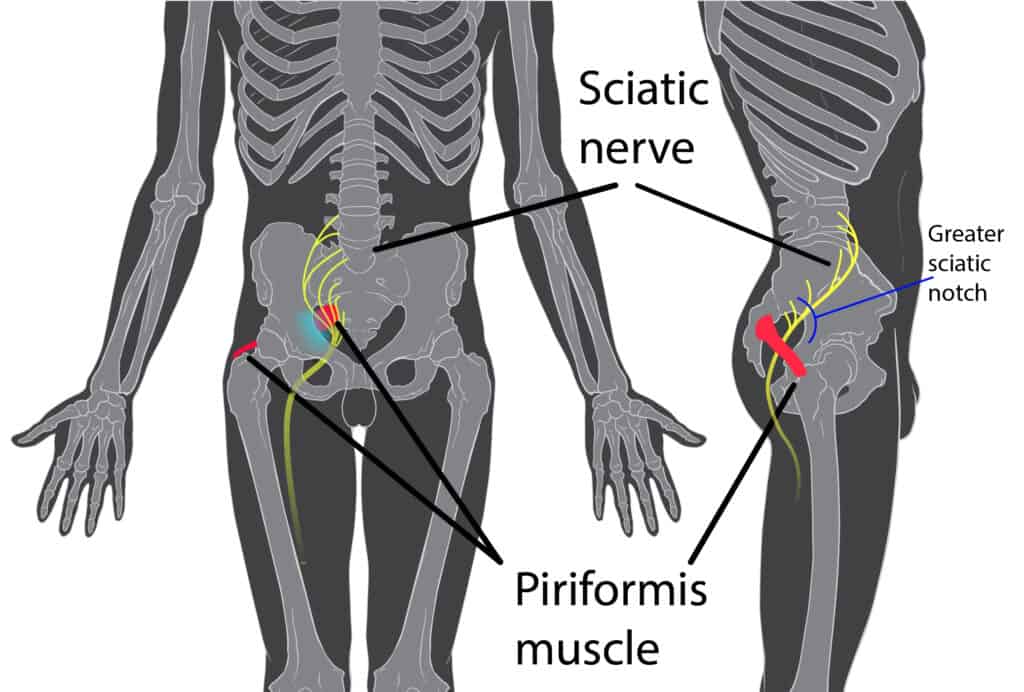
Piriformis Stretch Syndrome is buttock pain caused by the spasms of the piriformis muscle muscles in your buttocks. As a result of the muscle spasm causing irritation of your sciatic nerve, you may also feel pain, tingling, or numbness in the back of your legs.
When rowing with an indoor rowing machine, you want to position yourself properly since this helps prevent muscle spasms. Usually, your piriformis muscle assists you in rotating at your hip or turning your leg and, of course, the foot outward.
So, anything that prevents your legs and feet from turning outward as they would normally do might cause your piriformis muscle to spasm.
Placing your feet properly in the “flexfoot” holders with the straps running across the ball of your feet gives you room to turn your legs and feet outward without pressure on your piriformis muscle.
So, consider maintaining proper positioning when rowing to prevent rowing machine butt pain. Also, you want to keep yourself well centered in your rowing machine seat. And that’s because sitting any other way affects the even distribution of your weight to the butt muscles. And this might cause your piriformis muscle to spasm.
How do you Avoid Sciatic Nerve Pain on a Rowing Machine?
Sciatic nerve pain is the back pain you feel when sitting or lying on a rowing machine. Usually, it is a pain radiating along your sciatic nerve. Located deep in your buttock and running down your thigh’s back to your heel and foot sole, the sciatic nerve is a union of five nerve roots from your lower back.
If you sit for long periods on your rowing machine, your herniated discs might irritate or compress the sciatic nerve causing back pain. But you can avoid Sciatic Nerve Pain by avoiding the following exercises:
Excessive Hamstring Stretching
Your hamstring muscles usually become sensitive when you suffer from sciatic nerve pain. And stretching these muscles also stretches your sciatic nerve. But excessive hamstring stretching puts unnecessary pressure on your sciatic nerve.
And this only delays your recovery time from this back pain. So, even when stretching your hamstring muscles, you want to avoid overstretching them; this is essential to speed up your recovery time.
Full Body Squats
Considered the most dangerous workout for anyone suffering from sciatic nerve pain, this exercise, especially when using barbells, puts stress on your lower back. As a result, your discs might herniate, causing the sciatic nerve pain to worsen. So, you want to avoid full-body squats until you fully recover from this back pain.
Leg Lifts
Leg lifts usually make you straighten your legs. But this puts pressure on your spinal cord. With pressure exerted on your lower back, you might further complicate your sciatica or sciatic nerve pain due to this pressure. So, the best thing is to avoid this exercise altogether.
Bent Over Rowing
Bent over rowing affects your spine’s natural shape. It does this by disrupting your spine’s structure. As a result, it might lead to the inflammation of your sciatic nerve. And this will cause sciatica pain. Once again, you want to avoid this exercise if you suffer from pain due to sciatica.
What Are the Risk Factors for a Rowing Machine butt Pain?
Sciatic nerve pain risk factors include prolonged sitting, obesity, diabetes, age, and some occupations; there are more risk factors. As you might already know, sciatica results when the sciatic nerve becomes pinched. The main cause for compressing the sciatic nerve is your herniated disk.
But even your overgrown bone spur can compress this nerve. And in some rare cases, a tumor might also be the cause. So, here’s how these factors increase your risk for rowing machine butt pain:
Prolonged Sitting
A sedentary lifestyle involves sitting at a desk for extended periods. Usually, it leads to more compression to your sciatic nerve, increasing your chances of developing sciatica.
Diabetes
Diabetes affects how your body uses its blood sugar. And this increases the diabetic neuropathy risk, leading to damaged nerves in the legs and hands. As a result of a damaged nerve in your leg, you might experience the same symptoms as sciatica.
Obesity
Usually, obesity increases stress on your spinal cord. And this causes a spinal change that might trigger sciatica.
Age
A herniated disc is the problem with the rubbery cushion sitting between the vertebrae. Usually, these discs are more in your lower back. But they can also occur in your neck. As you grow older, you might develop a herniated disc which might compress your sciatic nerve. As a result, you might develop sciatic nerve pain.
Occupation
Although there’s no clear evidence that occupation might cause sciatic nerve pain, some jobs are thought to increase your chances of experiencing sciatica. Usually, these jobs require you to carry heavy loads or twist your back. Also, driving a motor vehicle for extended periods could be a risk factor.
How Do You Use a Rowing Machine with Butt Pain?
You can use your rowing machine even if you have butt pain if you have the best rowing machine seat cushion. I list the top designs in my seat cushion post.
When Should You Seek Medical Advice for a Rower’s Bum?
You should seek medical advice when your back pain travels down your leg. Also, you want to see a doctor if you feel numbness or tingling in the affected area.
If your rower’s bum results from sciatica, you might experience some complications. Besides numbness usually in your left leg, you might also experience problems with your bladder or bowel functions. Also, the affected leg might be weak. These are complications to make you see a doctor.
How Do I Prevent a Rower’s Bum?
You can prevent a rower’s bum if you exercise regularly, maintain proper sitting posture, and use the recommended body mechanics.
Regular exercises strengthen your core muscles and open your blood vessels for improved circulation.
You can ask your doctor for advice on some specific activities to strengthen your core muscles. Following your doctor’s recommendations is key!
Then you can perform the recommended exercises to prevent rowing machine butt pain.
Additionally, you want to maintain an excellent sitting posture to prevent lower back pain. The best thing to do is look for a seat with exceptional lower back support.
You also want to ensure your preferred seat has an armrest. Additionally, it should have a swivel base.
You can also place a pillow on your lower back (small of the back) and have your knees bent and on the same level as the hips.
Lastly, you want to tap into your body’s good mechanics. You want to avoid lifting weight as you also twist at the same time.
You want to find someone to help you bear the weight. At the same time, you can rest one foot on something raised, such as a stool, from time to time; this is essential if you stand for extended periods.
Once again, let the lower body muscles bear the weight when lifting. Also, you want to lift with your body moving straight up or down.
So, that means you want to keep your back straight, allowing you only to have your knees bent to pick up something. These practices might help prevent a rower’s bum.
Does a Stretch Prevent a Rower’s Bum?
Yes, stretching specific muscles can prevent a rower’s bum. Usually, stretching builds flexibility in the stretched muscles. And you require flexible legs, hip, shoulder, and backs, among a few more areas, to perform a stroke.
For gluteal stretches, you want to pull your knee across your body. Then you want to cross your legs and pull the crossed knee to your chest.
Then hold the stretch for 30 seconds. You can then repeat this process with the other knee.
You can also stretch your hamstrings. You will do this by pulling one knee towards your chest. Then straighten that knee until you feel the back of your thigh stretch.
Then hold the stretch for 30 seconds. You can repeat this with the other knee. You can learn more about these stretches from my seat cushion post.
Rowing Butt Pain – Final Thoughts
Hopefully after reading this article you have a few ideas on how to cure your rowers bum.
Most people will find trying a few of these solutions will help solve their rowing machine butt pain.
For me, stretching and time are the best ways to alleviate rowing bum pain.
Sitting in a chair all day can cause very tight muscles in the butt, so we need to loosen these muscles up. Rolling on a lacrosse ball is one of my favorite ways to do this!
Your butt must also get used to rowing. If you are a new rower, give it a few weeks and hopefully some of the soreness will disappear.
If all else fails, stick a nice, soft rowing machine seat pad under that bum and kiss that pain goodbye!
I hope you enjoyed my article on curing rowing machine butt pain. If you have any great solutions that weren’t mentioned in this article, please leave them in the comment section below!
Recommended Reading
The Ultimate Guide to Rowing Machine Back Pain

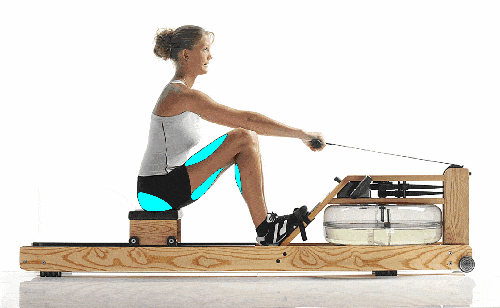
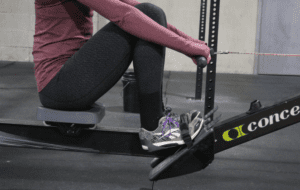

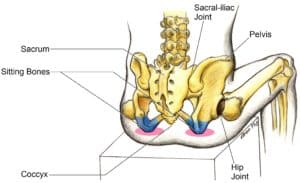
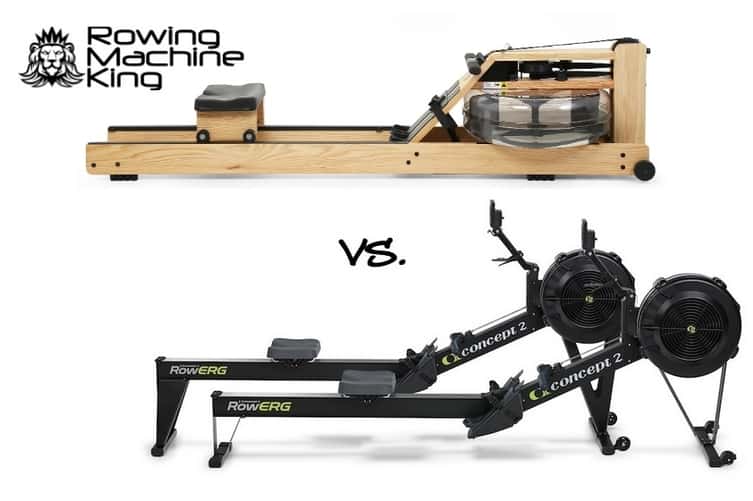
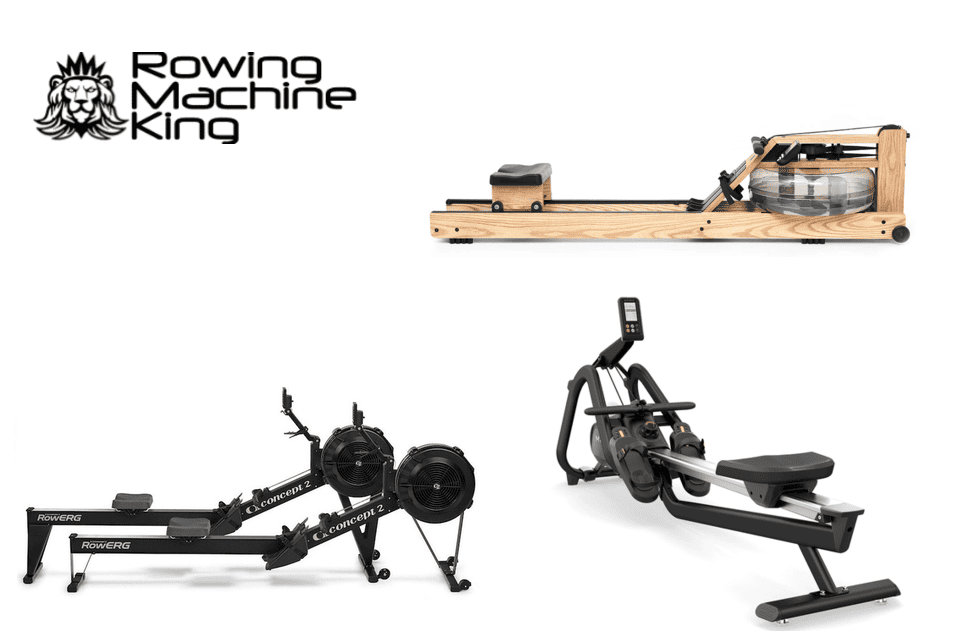
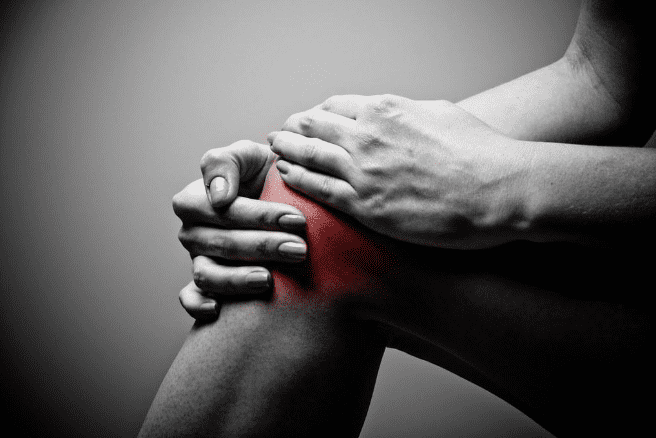
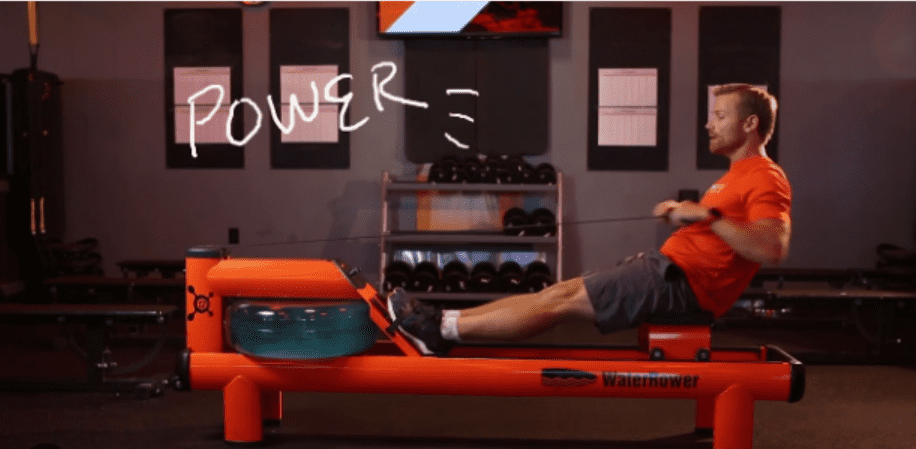
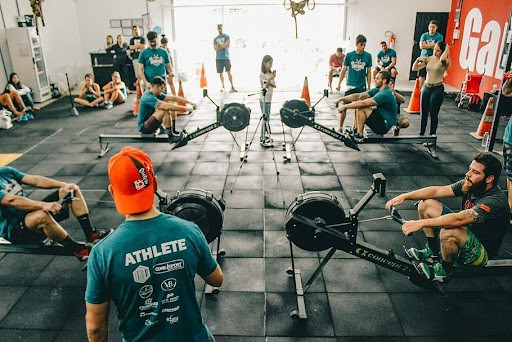
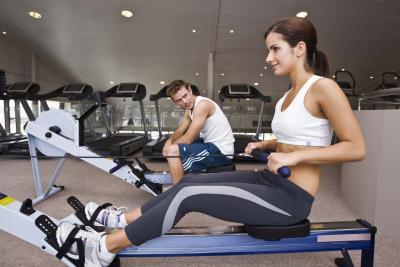
RP3 Filipi seat with the HUGE holes + my homemade Concept 2 shaped seat with the holes expanded to more than match the RP3 seat holes, is actually tolerable! The holes allow my (scant) flesh and sit bones to bulge down through the holes, avoiding most pressure.
Ergs and boats, chairs, car&plane seats—anything, are increasingly painful for me over the past 2 years. I’m kneeling at my computer right now.
I guess I’m what you’d call an Elite Level Master Rower (just turned 65 y.o., rowing over 40 years–have C2 WRs and many wins internationally on water) but I sure don’t look forward to this constant pain.
Dick Dreissigaker recommends bubble wrap, but that didn’t help. Sue
Hi Sue,
Thanks for the comment! Yeah some of us don’t have as much cushion down there to help with the pain.
Thanks for the tips, let us know if you have anymore! You have had an amazing career! Keep it up :)
Very well written and a great help. Thank you.
You’re welcome! Thank you for the kind words
What about skin sores? I have a sore on my bum because of the rubbing when I am on my rowing machine. Do you have any suggestions? Its kinda painful.
Hi Kim – I do not get that from rowing but I do cycle and some people have this issue. They use “chamois cream”. There is a brand Chamois buttr and Skin Glide that I think are popular. I also read Rich Roll’s book (not sure if you know who he is) but he used Tee Tree Oil when he got sores from cycling. Maybe those will help! The tee tree oil could sting if the sore is open though.
It’s more where the coccyx that hurts me..it’s like it’s bruised. Why is that?
Hi Yola – the coccyx can feel like it’s bruised because when you are leaning back it is hitting the seat. A cushion can help or try sitting up straight and not slouching which will raise your coccyx off the seat.